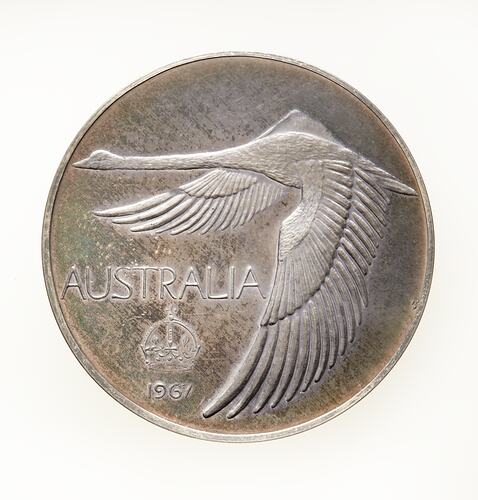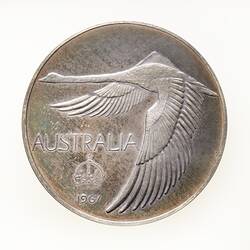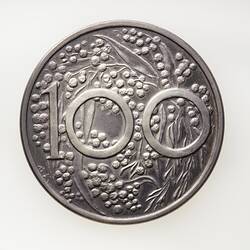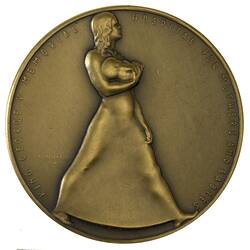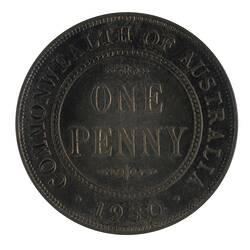Summary
Unofficial Australian Pattern 'Crown' Proof Dollar with case, commissioned by the Australian Coin Review. Designed by Andor Mészáros and minted by Pinches of London in 1967.
John Gartner, noted numismatist and founder of the Australian Coin Review, was disappointed that Australia's new decimal currency, launched in 1966, did not include a dollar coin. In order to resolve the 'deficiency', he sponsored a design competition in the magazine for an 'unofficial crown' of Australia. The winning design was by Andor Mészáros (1900-1972), a noted medallist. Mészáros had been one of six artists selected to submit designs for the new decimal coins; he lost the currency competition to Stuart Devlin. Andor reworked his flying swan design for the 20-cent piece for the obverse and the wattle from his two-cent coin design for the reverse, and submitted them to the Australian Coin Review.
In 1967, the magazine issued unofficial souvenir proof and standard coins. The coin was not official currency but it was popular with collectors and the initial issue rapidly sold out; a total of 4000 pieces in gold or silver were struck. Although the image is of a swan, the coin is known colloquially as the Goose Dollar, perhaps because of its resemblance to Canada's centennial dollar issued the same year, which featured a Canada goose in flight. Its commissioning and subsequent popularity demonstrates the depth of interest in Australian numismatic circles to have a coin that was distinctively Australian but also conformed to the interests of serious collectors both at home and abroad.
Physical Description
Silver coin in maroon leatherette case.
Obverse Description
Black swan in flight. Below, AUSTRALIA / [a crown] / 1967.
Reverse Description
Cluster of wattle. The number 100 superimposed, with the 1 larger than the 00.
Edge Description
Plain
Significance
For over half a century, sculptors Andor (1900-1973) and Michael (1945- ) Meszaros have created medals that reflect the high points of life in Australia. From major awards and portraits of eminent Australians to artwork celebrating popular culture and the natural world, these objects illuminate our culture and history. Grounded in a centuries-old European art tradition, the medals create connections across disciplines and link such diverse subjects as scientific advances, religious themes, sport, the performing arts and motherhood. Through their public and private commissions and their personal artworks, the Meszaros sculptors have defined the modern Australian medal.
More Information
-
Collection Names
-
Collecting Areas
-
Acquisition Information
Purchase
-
Date Issued
1967 AD
-
Issued By
-
Designer
-
Sponsor
-
Inscriptions
Obverse: AUSTRALIA / [a crown] / 1967. Reverse: 100
-
Denomination
-
Material
Silver
-
Classification
-
Category
-
Discipline
-
Type of item
-
Object Dimensions
3 mm (Height), 38 mm (Outside Diameter), 28.72 g (Weight)
-
Shape
Round
-
References
Crellin, Andrew.. Andor Mészáros : The 1967 Goose Dollar and the 2009 Silver Proof Coins. 2009. [Link 1]
[Catalogue] Sharples, John P. 1990. Medals as Art: Australia and the Meszaros Tradition.
-
Keywords
Coin Collecting, Sculpture, Artistic Practices, Artists, Swans, Wattles, Flora, Fauna
